Strategic Management in Non-profit Organizations: A Report
VerifiedAdded on 2020/04/13
|12
|2461
|220
Report
AI Summary
This report presents a literature review on strategic management within nonprofit organizations, examining its critical role in achieving organizational success. It explores how strategic management differs in the nonprofit sector compared to for-profit entities, highlighting the need for adapting strategies to address unique challenges such as funding limitations, tax regulations, and stakeholder engagement. The report delves into key theories like the Balanced Scorecard, Resource Dependency Theory, and Strategic Communication Management, analyzing their application and impact on nonprofit performance. It discusses the importance of stakeholder relationships, transparency, and accountability, while also considering challenges like declining government funding and increased competition. The review concludes that strategic management, encompassing planning, communication, and resource management, is essential for nonprofit organizations to navigate complexities, achieve their missions, and ensure long-term sustainability. It also stresses the importance of training in strategic communication management for nonprofit leaders to effectively implement these strategies. Access past papers and solved assignments on Desklib to further your understanding of this topic and enhance your academic performance.
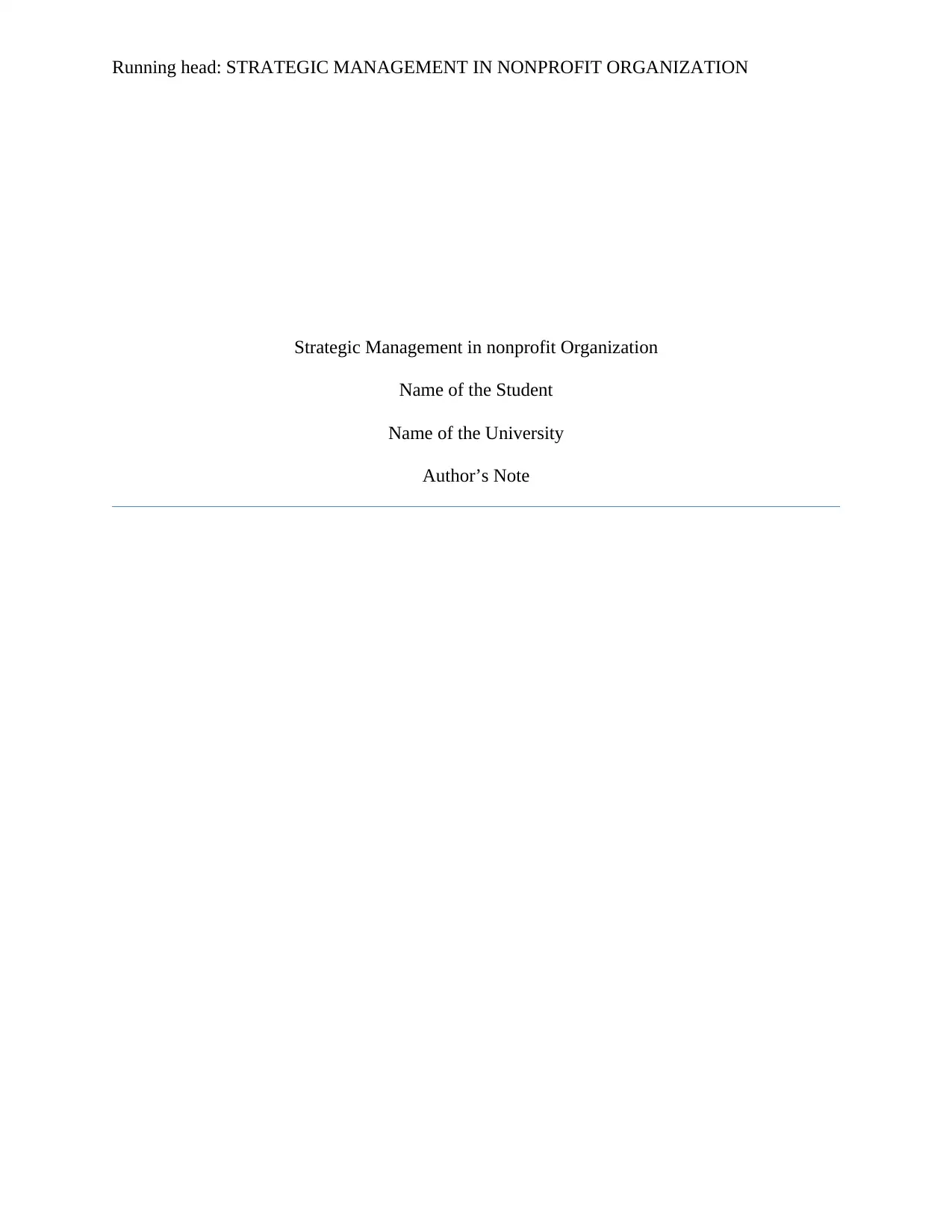
Running head: STRATEGIC MANAGEMENT IN NONPROFIT ORGANIZATION
Strategic Management in nonprofit Organization
Name of the Student
Name of the University
Author’s Note
Strategic Management in nonprofit Organization
Name of the Student
Name of the University
Author’s Note
Paraphrase This Document
Need a fresh take? Get an instant paraphrase of this document with our AI Paraphraser
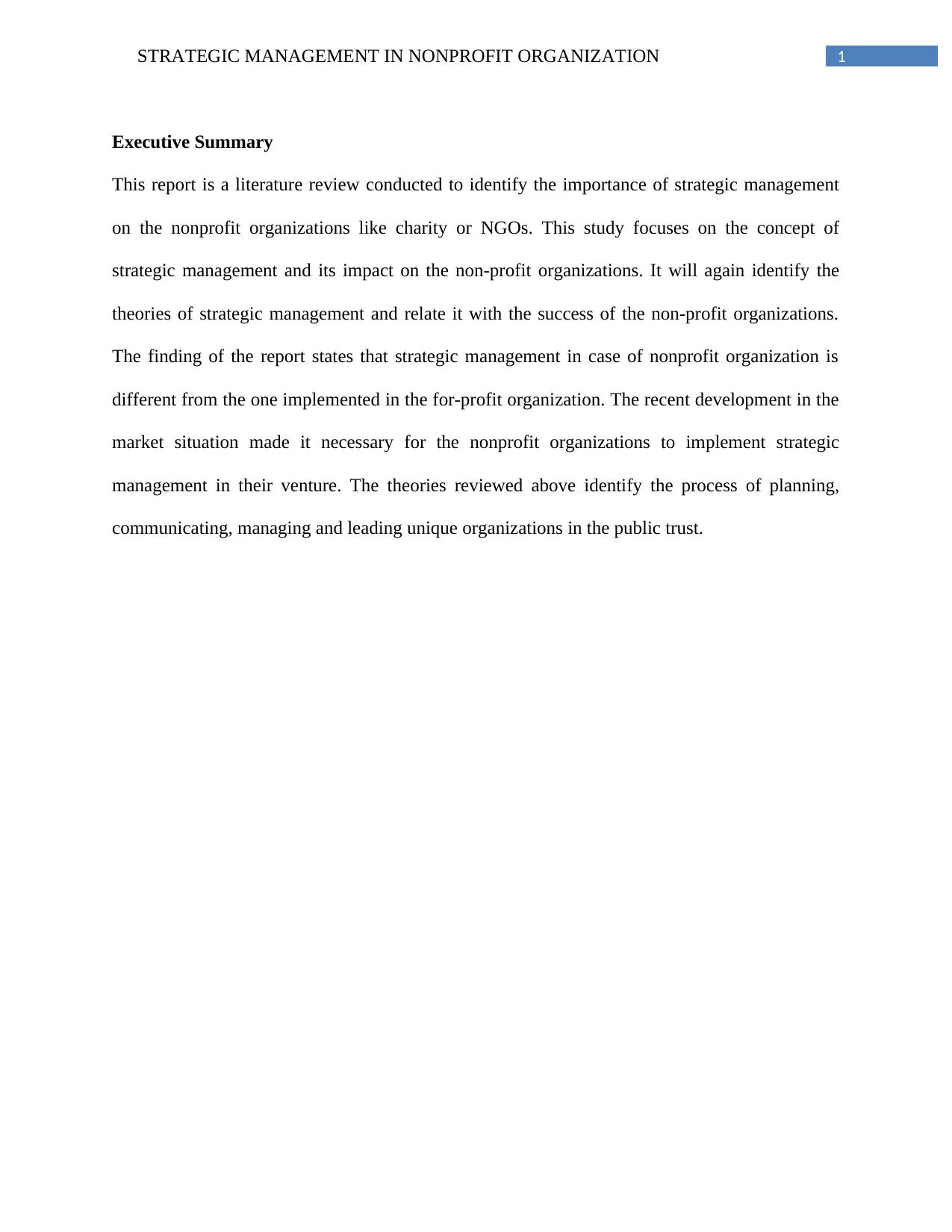
1STRATEGIC MANAGEMENT IN NONPROFIT ORGANIZATION
Executive Summary
This report is a literature review conducted to identify the importance of strategic management
on the nonprofit organizations like charity or NGOs. This study focuses on the concept of
strategic management and its impact on the non-profit organizations. It will again identify the
theories of strategic management and relate it with the success of the non-profit organizations.
The finding of the report states that strategic management in case of nonprofit organization is
different from the one implemented in the for-profit organization. The recent development in the
market situation made it necessary for the nonprofit organizations to implement strategic
management in their venture. The theories reviewed above identify the process of planning,
communicating, managing and leading unique organizations in the public trust.
Executive Summary
This report is a literature review conducted to identify the importance of strategic management
on the nonprofit organizations like charity or NGOs. This study focuses on the concept of
strategic management and its impact on the non-profit organizations. It will again identify the
theories of strategic management and relate it with the success of the non-profit organizations.
The finding of the report states that strategic management in case of nonprofit organization is
different from the one implemented in the for-profit organization. The recent development in the
market situation made it necessary for the nonprofit organizations to implement strategic
management in their venture. The theories reviewed above identify the process of planning,
communicating, managing and leading unique organizations in the public trust.
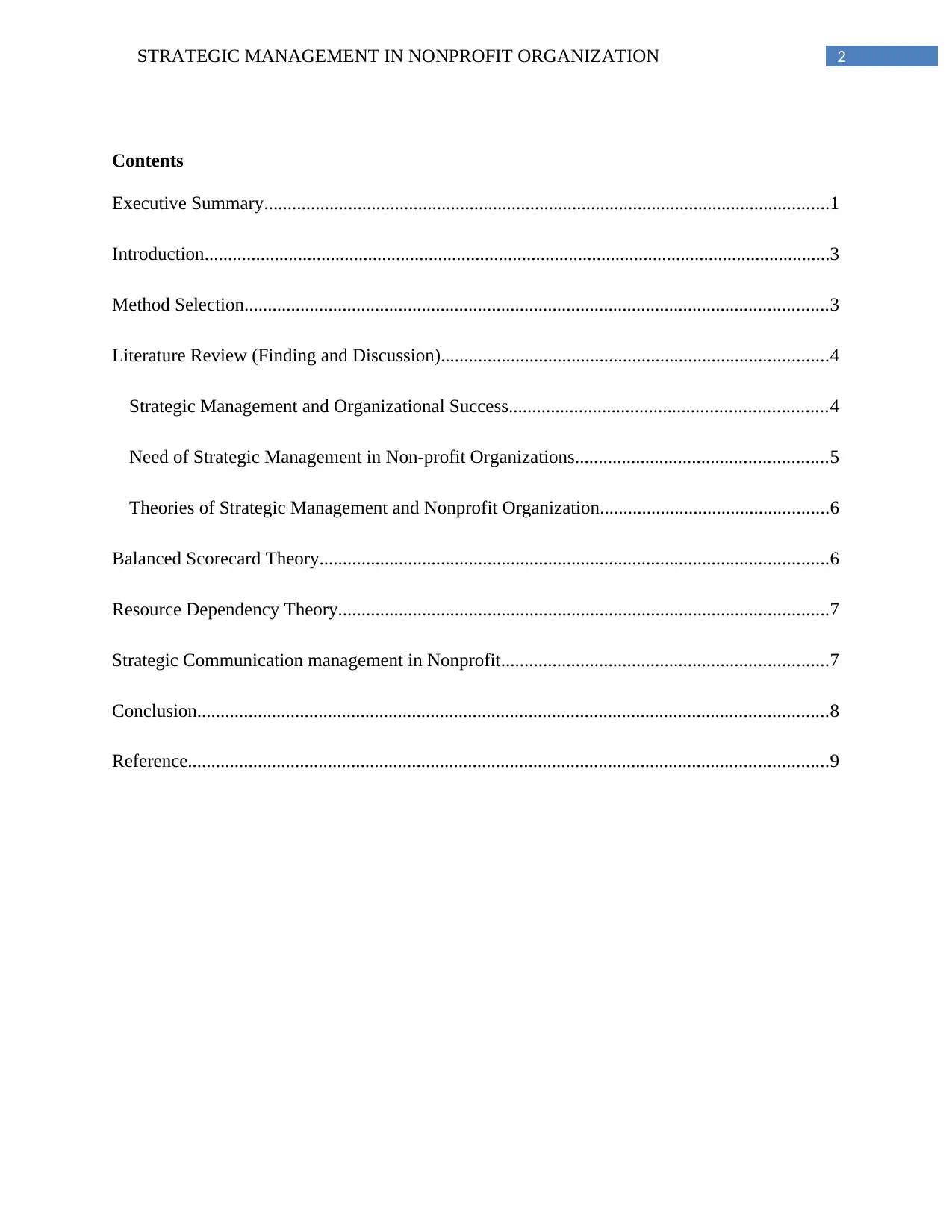
2STRATEGIC MANAGEMENT IN NONPROFIT ORGANIZATION
Contents
Executive Summary.........................................................................................................................1
Introduction......................................................................................................................................3
Method Selection.............................................................................................................................3
Literature Review (Finding and Discussion)...................................................................................4
Strategic Management and Organizational Success....................................................................4
Need of Strategic Management in Non-profit Organizations......................................................5
Theories of Strategic Management and Nonprofit Organization.................................................6
Balanced Scorecard Theory.............................................................................................................6
Resource Dependency Theory.........................................................................................................7
Strategic Communication management in Nonprofit......................................................................7
Conclusion.......................................................................................................................................8
Reference.........................................................................................................................................9
Contents
Executive Summary.........................................................................................................................1
Introduction......................................................................................................................................3
Method Selection.............................................................................................................................3
Literature Review (Finding and Discussion)...................................................................................4
Strategic Management and Organizational Success....................................................................4
Need of Strategic Management in Non-profit Organizations......................................................5
Theories of Strategic Management and Nonprofit Organization.................................................6
Balanced Scorecard Theory.............................................................................................................6
Resource Dependency Theory.........................................................................................................7
Strategic Communication management in Nonprofit......................................................................7
Conclusion.......................................................................................................................................8
Reference.........................................................................................................................................9
⊘ This is a preview!⊘
Do you want full access?
Subscribe today to unlock all pages.

Trusted by 1+ million students worldwide
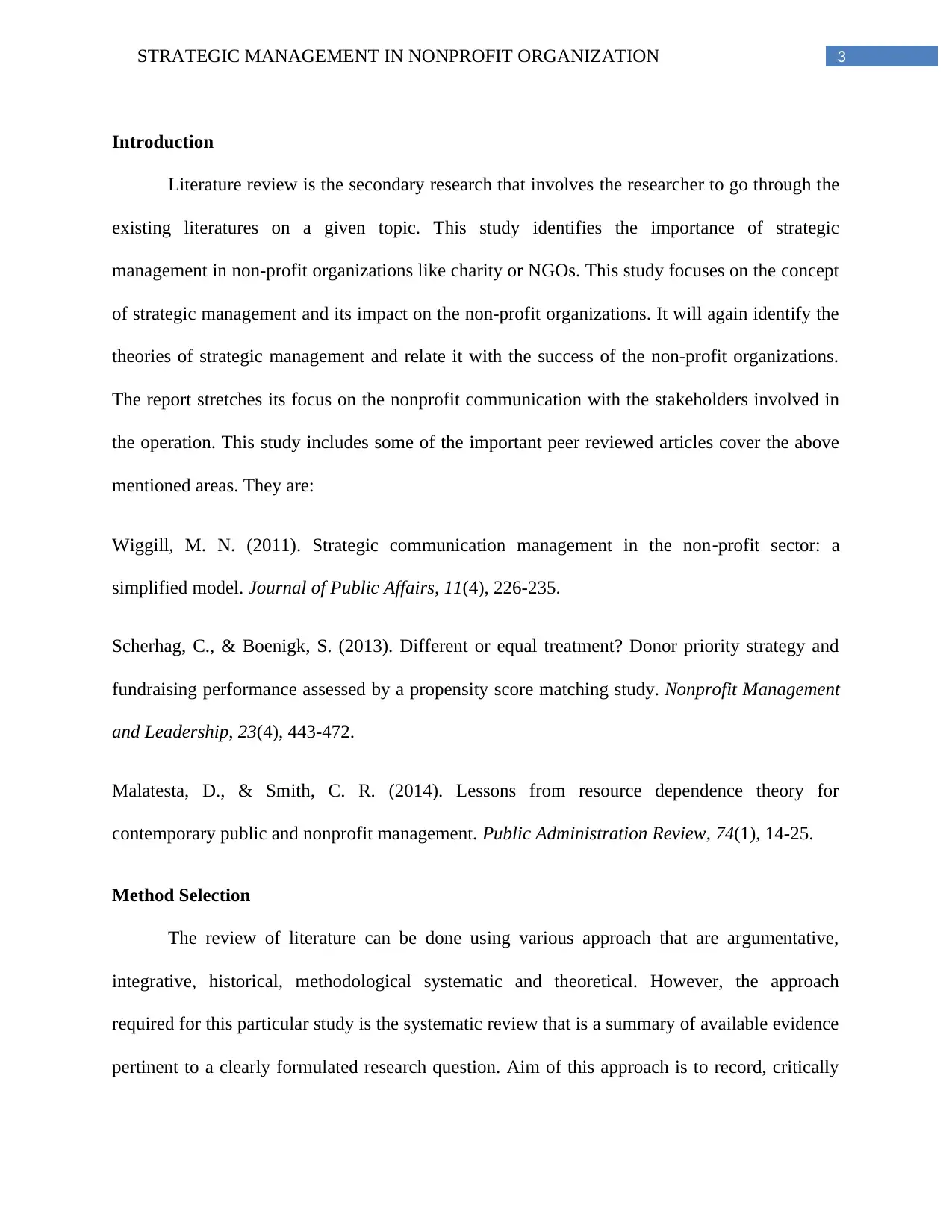
3STRATEGIC MANAGEMENT IN NONPROFIT ORGANIZATION
Introduction
Literature review is the secondary research that involves the researcher to go through the
existing literatures on a given topic. This study identifies the importance of strategic
management in non-profit organizations like charity or NGOs. This study focuses on the concept
of strategic management and its impact on the non-profit organizations. It will again identify the
theories of strategic management and relate it with the success of the non-profit organizations.
The report stretches its focus on the nonprofit communication with the stakeholders involved in
the operation. This study includes some of the important peer reviewed articles cover the above
mentioned areas. They are:
Wiggill, M. N. (2011). Strategic communication management in the non‐profit sector: a
simplified model. Journal of Public Affairs, 11(4), 226-235.
Scherhag, C., & Boenigk, S. (2013). Different or equal treatment? Donor priority strategy and
fundraising performance assessed by a propensity score matching study. Nonprofit Management
and Leadership, 23(4), 443-472.
Malatesta, D., & Smith, C. R. (2014). Lessons from resource dependence theory for
contemporary public and nonprofit management. Public Administration Review, 74(1), 14-25.
Method Selection
The review of literature can be done using various approach that are argumentative,
integrative, historical, methodological systematic and theoretical. However, the approach
required for this particular study is the systematic review that is a summary of available evidence
pertinent to a clearly formulated research question. Aim of this approach is to record, critically
Introduction
Literature review is the secondary research that involves the researcher to go through the
existing literatures on a given topic. This study identifies the importance of strategic
management in non-profit organizations like charity or NGOs. This study focuses on the concept
of strategic management and its impact on the non-profit organizations. It will again identify the
theories of strategic management and relate it with the success of the non-profit organizations.
The report stretches its focus on the nonprofit communication with the stakeholders involved in
the operation. This study includes some of the important peer reviewed articles cover the above
mentioned areas. They are:
Wiggill, M. N. (2011). Strategic communication management in the non‐profit sector: a
simplified model. Journal of Public Affairs, 11(4), 226-235.
Scherhag, C., & Boenigk, S. (2013). Different or equal treatment? Donor priority strategy and
fundraising performance assessed by a propensity score matching study. Nonprofit Management
and Leadership, 23(4), 443-472.
Malatesta, D., & Smith, C. R. (2014). Lessons from resource dependence theory for
contemporary public and nonprofit management. Public Administration Review, 74(1), 14-25.
Method Selection
The review of literature can be done using various approach that are argumentative,
integrative, historical, methodological systematic and theoretical. However, the approach
required for this particular study is the systematic review that is a summary of available evidence
pertinent to a clearly formulated research question. Aim of this approach is to record, critically
Paraphrase This Document
Need a fresh take? Get an instant paraphrase of this document with our AI Paraphraser
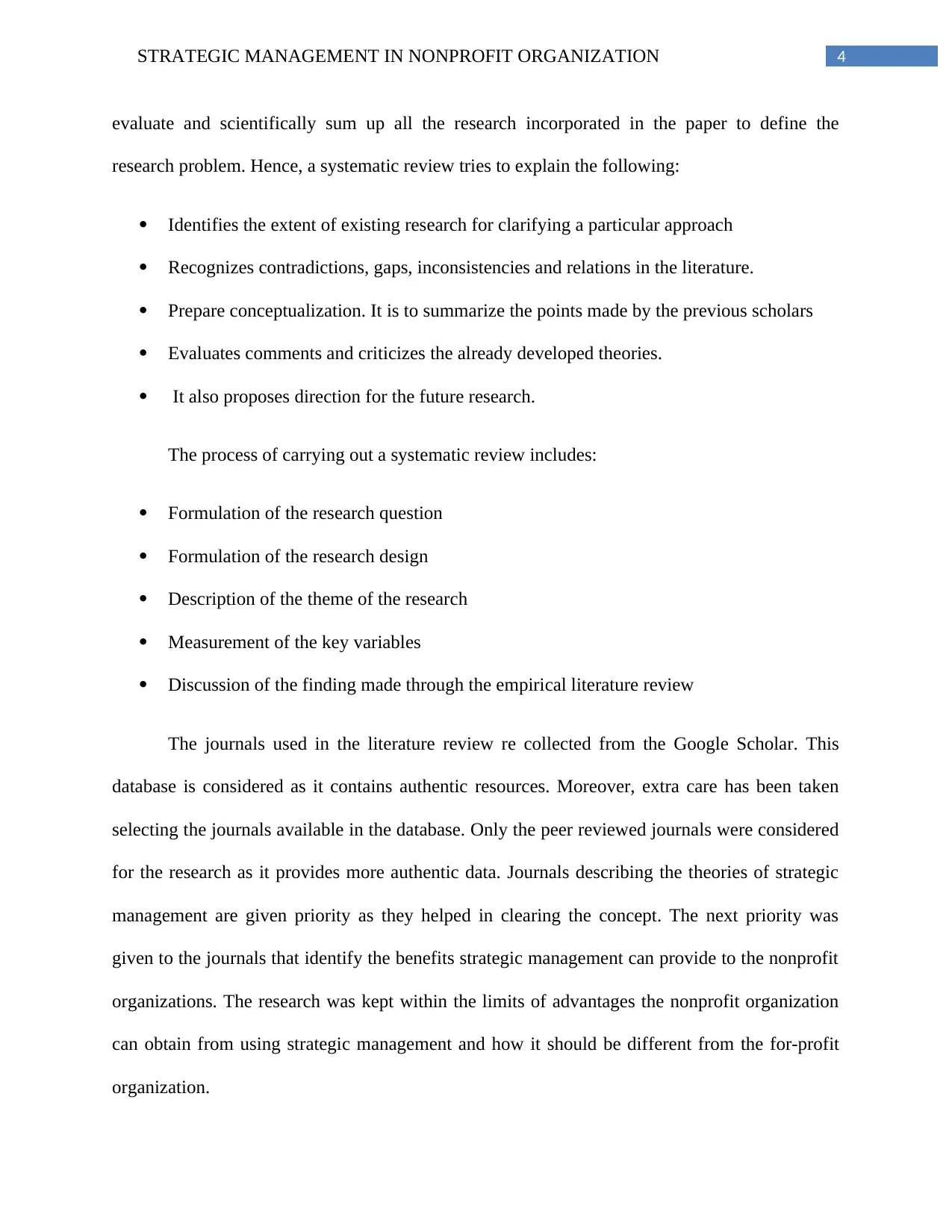
4STRATEGIC MANAGEMENT IN NONPROFIT ORGANIZATION
evaluate and scientifically sum up all the research incorporated in the paper to define the
research problem. Hence, a systematic review tries to explain the following:
Identifies the extent of existing research for clarifying a particular approach
Recognizes contradictions, gaps, inconsistencies and relations in the literature.
Prepare conceptualization. It is to summarize the points made by the previous scholars
Evaluates comments and criticizes the already developed theories.
It also proposes direction for the future research.
The process of carrying out a systematic review includes:
Formulation of the research question
Formulation of the research design
Description of the theme of the research
Measurement of the key variables
Discussion of the finding made through the empirical literature review
The journals used in the literature review re collected from the Google Scholar. This
database is considered as it contains authentic resources. Moreover, extra care has been taken
selecting the journals available in the database. Only the peer reviewed journals were considered
for the research as it provides more authentic data. Journals describing the theories of strategic
management are given priority as they helped in clearing the concept. The next priority was
given to the journals that identify the benefits strategic management can provide to the nonprofit
organizations. The research was kept within the limits of advantages the nonprofit organization
can obtain from using strategic management and how it should be different from the for-profit
organization.
evaluate and scientifically sum up all the research incorporated in the paper to define the
research problem. Hence, a systematic review tries to explain the following:
Identifies the extent of existing research for clarifying a particular approach
Recognizes contradictions, gaps, inconsistencies and relations in the literature.
Prepare conceptualization. It is to summarize the points made by the previous scholars
Evaluates comments and criticizes the already developed theories.
It also proposes direction for the future research.
The process of carrying out a systematic review includes:
Formulation of the research question
Formulation of the research design
Description of the theme of the research
Measurement of the key variables
Discussion of the finding made through the empirical literature review
The journals used in the literature review re collected from the Google Scholar. This
database is considered as it contains authentic resources. Moreover, extra care has been taken
selecting the journals available in the database. Only the peer reviewed journals were considered
for the research as it provides more authentic data. Journals describing the theories of strategic
management are given priority as they helped in clearing the concept. The next priority was
given to the journals that identify the benefits strategic management can provide to the nonprofit
organizations. The research was kept within the limits of advantages the nonprofit organization
can obtain from using strategic management and how it should be different from the for-profit
organization.
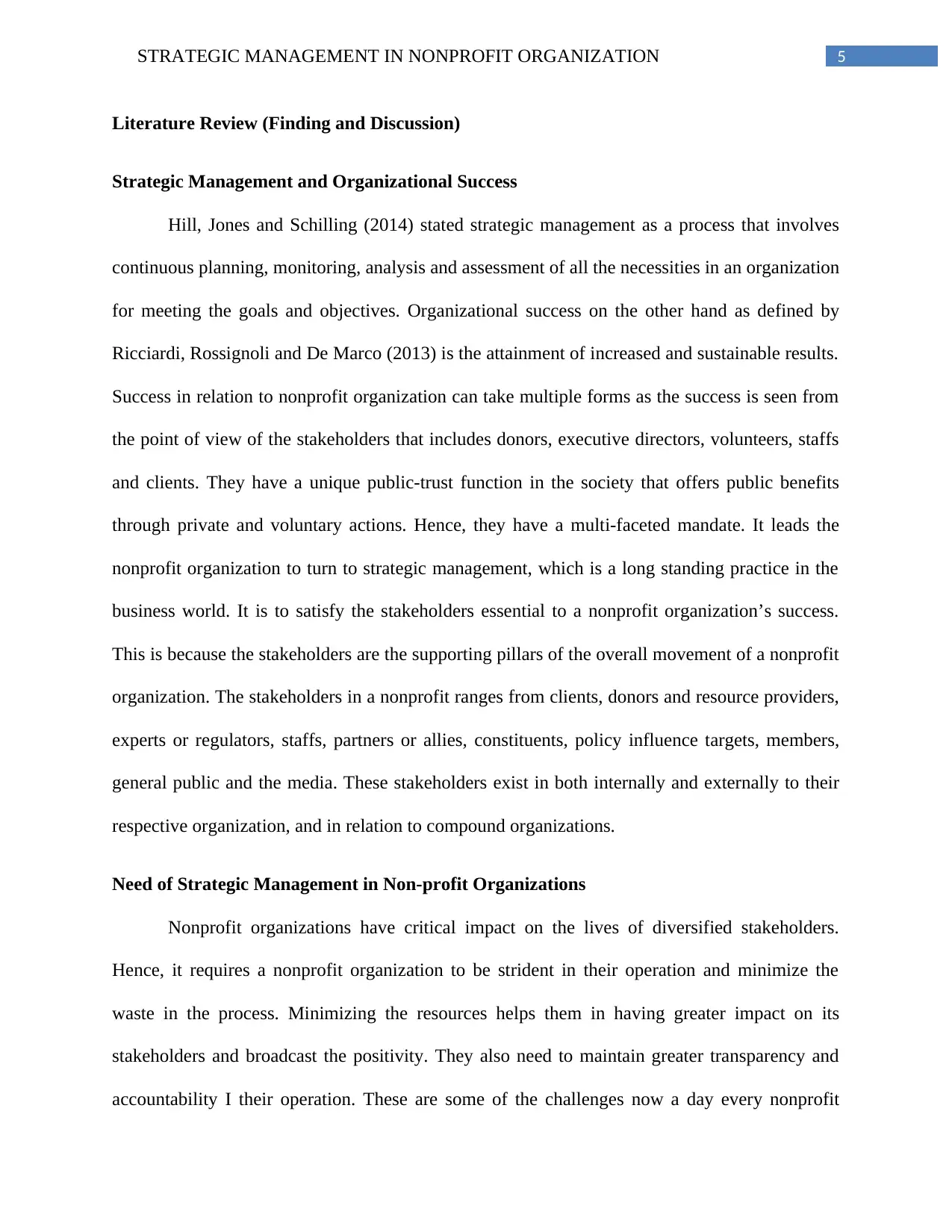
5STRATEGIC MANAGEMENT IN NONPROFIT ORGANIZATION
Literature Review (Finding and Discussion)
Strategic Management and Organizational Success
Hill, Jones and Schilling (2014) stated strategic management as a process that involves
continuous planning, monitoring, analysis and assessment of all the necessities in an organization
for meeting the goals and objectives. Organizational success on the other hand as defined by
Ricciardi, Rossignoli and De Marco (2013) is the attainment of increased and sustainable results.
Success in relation to nonprofit organization can take multiple forms as the success is seen from
the point of view of the stakeholders that includes donors, executive directors, volunteers, staffs
and clients. They have a unique public-trust function in the society that offers public benefits
through private and voluntary actions. Hence, they have a multi-faceted mandate. It leads the
nonprofit organization to turn to strategic management, which is a long standing practice in the
business world. It is to satisfy the stakeholders essential to a nonprofit organization’s success.
This is because the stakeholders are the supporting pillars of the overall movement of a nonprofit
organization. The stakeholders in a nonprofit ranges from clients, donors and resource providers,
experts or regulators, staffs, partners or allies, constituents, policy influence targets, members,
general public and the media. These stakeholders exist in both internally and externally to their
respective organization, and in relation to compound organizations.
Need of Strategic Management in Non-profit Organizations
Nonprofit organizations have critical impact on the lives of diversified stakeholders.
Hence, it requires a nonprofit organization to be strident in their operation and minimize the
waste in the process. Minimizing the resources helps them in having greater impact on its
stakeholders and broadcast the positivity. They also need to maintain greater transparency and
accountability I their operation. These are some of the challenges now a day every nonprofit
Literature Review (Finding and Discussion)
Strategic Management and Organizational Success
Hill, Jones and Schilling (2014) stated strategic management as a process that involves
continuous planning, monitoring, analysis and assessment of all the necessities in an organization
for meeting the goals and objectives. Organizational success on the other hand as defined by
Ricciardi, Rossignoli and De Marco (2013) is the attainment of increased and sustainable results.
Success in relation to nonprofit organization can take multiple forms as the success is seen from
the point of view of the stakeholders that includes donors, executive directors, volunteers, staffs
and clients. They have a unique public-trust function in the society that offers public benefits
through private and voluntary actions. Hence, they have a multi-faceted mandate. It leads the
nonprofit organization to turn to strategic management, which is a long standing practice in the
business world. It is to satisfy the stakeholders essential to a nonprofit organization’s success.
This is because the stakeholders are the supporting pillars of the overall movement of a nonprofit
organization. The stakeholders in a nonprofit ranges from clients, donors and resource providers,
experts or regulators, staffs, partners or allies, constituents, policy influence targets, members,
general public and the media. These stakeholders exist in both internally and externally to their
respective organization, and in relation to compound organizations.
Need of Strategic Management in Non-profit Organizations
Nonprofit organizations have critical impact on the lives of diversified stakeholders.
Hence, it requires a nonprofit organization to be strident in their operation and minimize the
waste in the process. Minimizing the resources helps them in having greater impact on its
stakeholders and broadcast the positivity. They also need to maintain greater transparency and
accountability I their operation. These are some of the challenges now a day every nonprofit
⊘ This is a preview!⊘
Do you want full access?
Subscribe today to unlock all pages.

Trusted by 1+ million students worldwide
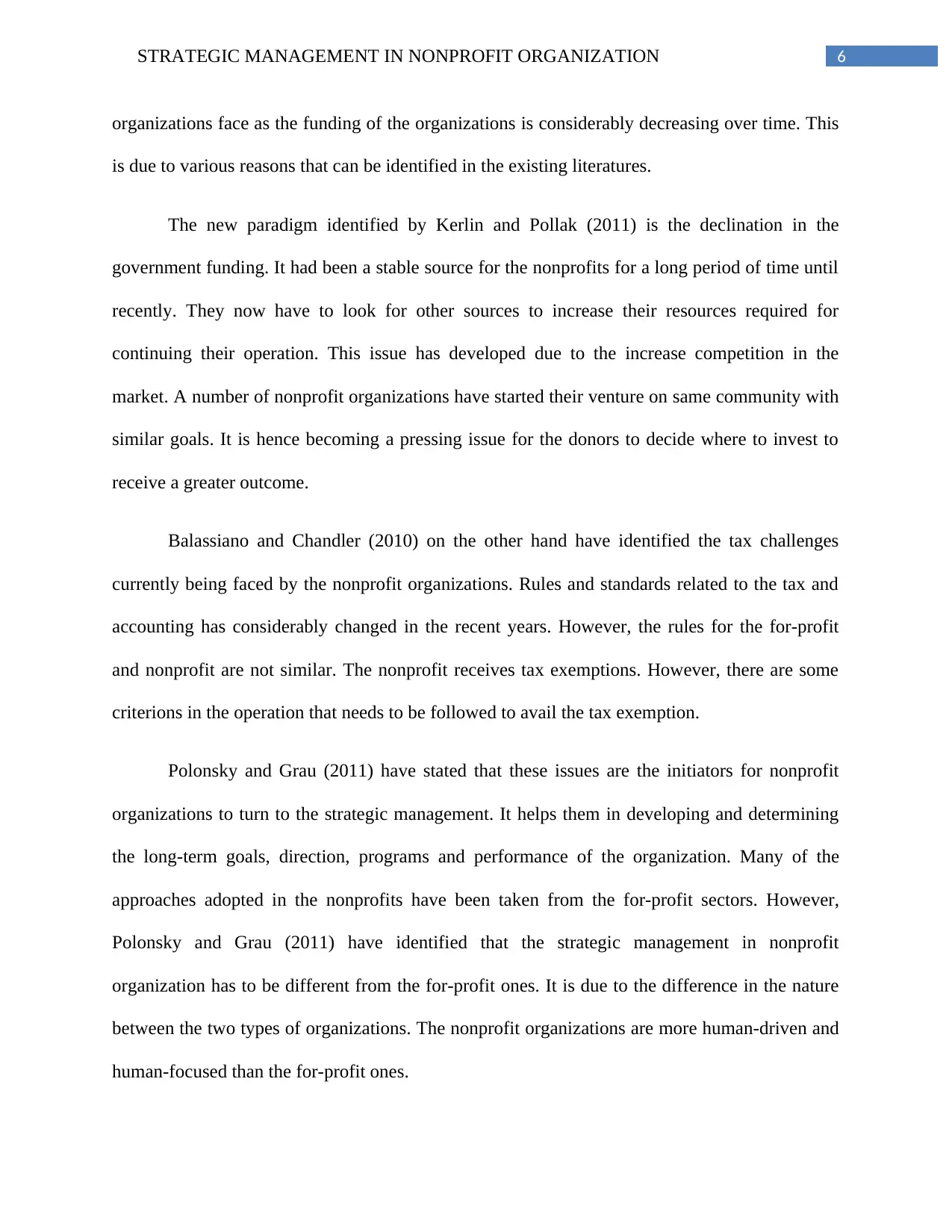
6STRATEGIC MANAGEMENT IN NONPROFIT ORGANIZATION
organizations face as the funding of the organizations is considerably decreasing over time. This
is due to various reasons that can be identified in the existing literatures.
The new paradigm identified by Kerlin and Pollak (2011) is the declination in the
government funding. It had been a stable source for the nonprofits for a long period of time until
recently. They now have to look for other sources to increase their resources required for
continuing their operation. This issue has developed due to the increase competition in the
market. A number of nonprofit organizations have started their venture on same community with
similar goals. It is hence becoming a pressing issue for the donors to decide where to invest to
receive a greater outcome.
Balassiano and Chandler (2010) on the other hand have identified the tax challenges
currently being faced by the nonprofit organizations. Rules and standards related to the tax and
accounting has considerably changed in the recent years. However, the rules for the for-profit
and nonprofit are not similar. The nonprofit receives tax exemptions. However, there are some
criterions in the operation that needs to be followed to avail the tax exemption.
Polonsky and Grau (2011) have stated that these issues are the initiators for nonprofit
organizations to turn to the strategic management. It helps them in developing and determining
the long-term goals, direction, programs and performance of the organization. Many of the
approaches adopted in the nonprofits have been taken from the for-profit sectors. However,
Polonsky and Grau (2011) have identified that the strategic management in nonprofit
organization has to be different from the for-profit ones. It is due to the difference in the nature
between the two types of organizations. The nonprofit organizations are more human-driven and
human-focused than the for-profit ones.
organizations face as the funding of the organizations is considerably decreasing over time. This
is due to various reasons that can be identified in the existing literatures.
The new paradigm identified by Kerlin and Pollak (2011) is the declination in the
government funding. It had been a stable source for the nonprofits for a long period of time until
recently. They now have to look for other sources to increase their resources required for
continuing their operation. This issue has developed due to the increase competition in the
market. A number of nonprofit organizations have started their venture on same community with
similar goals. It is hence becoming a pressing issue for the donors to decide where to invest to
receive a greater outcome.
Balassiano and Chandler (2010) on the other hand have identified the tax challenges
currently being faced by the nonprofit organizations. Rules and standards related to the tax and
accounting has considerably changed in the recent years. However, the rules for the for-profit
and nonprofit are not similar. The nonprofit receives tax exemptions. However, there are some
criterions in the operation that needs to be followed to avail the tax exemption.
Polonsky and Grau (2011) have stated that these issues are the initiators for nonprofit
organizations to turn to the strategic management. It helps them in developing and determining
the long-term goals, direction, programs and performance of the organization. Many of the
approaches adopted in the nonprofits have been taken from the for-profit sectors. However,
Polonsky and Grau (2011) have identified that the strategic management in nonprofit
organization has to be different from the for-profit ones. It is due to the difference in the nature
between the two types of organizations. The nonprofit organizations are more human-driven and
human-focused than the for-profit ones.
Paraphrase This Document
Need a fresh take? Get an instant paraphrase of this document with our AI Paraphraser
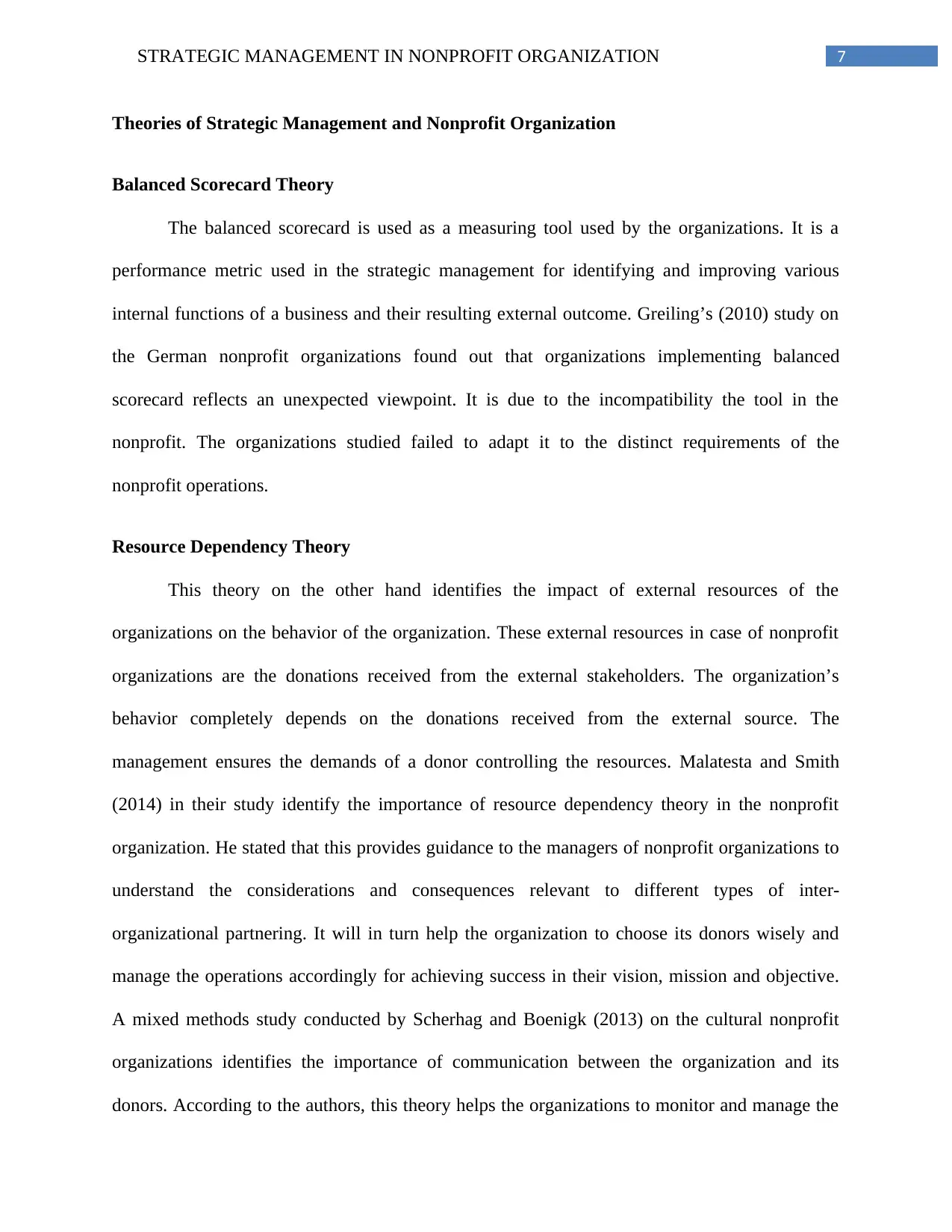
7STRATEGIC MANAGEMENT IN NONPROFIT ORGANIZATION
Theories of Strategic Management and Nonprofit Organization
Balanced Scorecard Theory
The balanced scorecard is used as a measuring tool used by the organizations. It is a
performance metric used in the strategic management for identifying and improving various
internal functions of a business and their resulting external outcome. Greiling’s (2010) study on
the German nonprofit organizations found out that organizations implementing balanced
scorecard reflects an unexpected viewpoint. It is due to the incompatibility the tool in the
nonprofit. The organizations studied failed to adapt it to the distinct requirements of the
nonprofit operations.
Resource Dependency Theory
This theory on the other hand identifies the impact of external resources of the
organizations on the behavior of the organization. These external resources in case of nonprofit
organizations are the donations received from the external stakeholders. The organization’s
behavior completely depends on the donations received from the external source. The
management ensures the demands of a donor controlling the resources. Malatesta and Smith
(2014) in their study identify the importance of resource dependency theory in the nonprofit
organization. He stated that this provides guidance to the managers of nonprofit organizations to
understand the considerations and consequences relevant to different types of inter-
organizational partnering. It will in turn help the organization to choose its donors wisely and
manage the operations accordingly for achieving success in their vision, mission and objective.
A mixed methods study conducted by Scherhag and Boenigk (2013) on the cultural nonprofit
organizations identifies the importance of communication between the organization and its
donors. According to the authors, this theory helps the organizations to monitor and manage the
Theories of Strategic Management and Nonprofit Organization
Balanced Scorecard Theory
The balanced scorecard is used as a measuring tool used by the organizations. It is a
performance metric used in the strategic management for identifying and improving various
internal functions of a business and their resulting external outcome. Greiling’s (2010) study on
the German nonprofit organizations found out that organizations implementing balanced
scorecard reflects an unexpected viewpoint. It is due to the incompatibility the tool in the
nonprofit. The organizations studied failed to adapt it to the distinct requirements of the
nonprofit operations.
Resource Dependency Theory
This theory on the other hand identifies the impact of external resources of the
organizations on the behavior of the organization. These external resources in case of nonprofit
organizations are the donations received from the external stakeholders. The organization’s
behavior completely depends on the donations received from the external source. The
management ensures the demands of a donor controlling the resources. Malatesta and Smith
(2014) in their study identify the importance of resource dependency theory in the nonprofit
organization. He stated that this provides guidance to the managers of nonprofit organizations to
understand the considerations and consequences relevant to different types of inter-
organizational partnering. It will in turn help the organization to choose its donors wisely and
manage the operations accordingly for achieving success in their vision, mission and objective.
A mixed methods study conducted by Scherhag and Boenigk (2013) on the cultural nonprofit
organizations identifies the importance of communication between the organization and its
donors. According to the authors, this theory helps the organizations to monitor and manage the
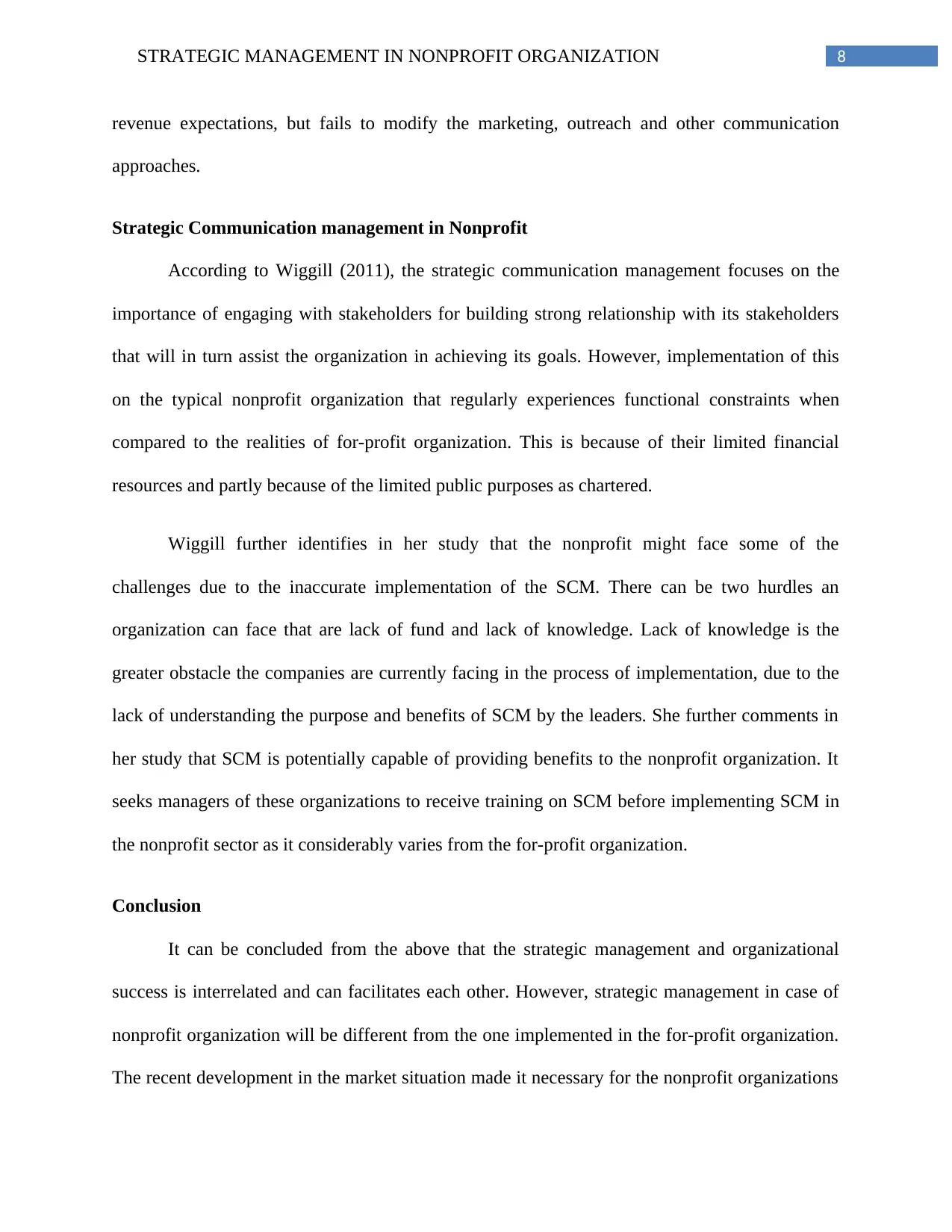
8STRATEGIC MANAGEMENT IN NONPROFIT ORGANIZATION
revenue expectations, but fails to modify the marketing, outreach and other communication
approaches.
Strategic Communication management in Nonprofit
According to Wiggill (2011), the strategic communication management focuses on the
importance of engaging with stakeholders for building strong relationship with its stakeholders
that will in turn assist the organization in achieving its goals. However, implementation of this
on the typical nonprofit organization that regularly experiences functional constraints when
compared to the realities of for-profit organization. This is because of their limited financial
resources and partly because of the limited public purposes as chartered.
Wiggill further identifies in her study that the nonprofit might face some of the
challenges due to the inaccurate implementation of the SCM. There can be two hurdles an
organization can face that are lack of fund and lack of knowledge. Lack of knowledge is the
greater obstacle the companies are currently facing in the process of implementation, due to the
lack of understanding the purpose and benefits of SCM by the leaders. She further comments in
her study that SCM is potentially capable of providing benefits to the nonprofit organization. It
seeks managers of these organizations to receive training on SCM before implementing SCM in
the nonprofit sector as it considerably varies from the for-profit organization.
Conclusion
It can be concluded from the above that the strategic management and organizational
success is interrelated and can facilitates each other. However, strategic management in case of
nonprofit organization will be different from the one implemented in the for-profit organization.
The recent development in the market situation made it necessary for the nonprofit organizations
revenue expectations, but fails to modify the marketing, outreach and other communication
approaches.
Strategic Communication management in Nonprofit
According to Wiggill (2011), the strategic communication management focuses on the
importance of engaging with stakeholders for building strong relationship with its stakeholders
that will in turn assist the organization in achieving its goals. However, implementation of this
on the typical nonprofit organization that regularly experiences functional constraints when
compared to the realities of for-profit organization. This is because of their limited financial
resources and partly because of the limited public purposes as chartered.
Wiggill further identifies in her study that the nonprofit might face some of the
challenges due to the inaccurate implementation of the SCM. There can be two hurdles an
organization can face that are lack of fund and lack of knowledge. Lack of knowledge is the
greater obstacle the companies are currently facing in the process of implementation, due to the
lack of understanding the purpose and benefits of SCM by the leaders. She further comments in
her study that SCM is potentially capable of providing benefits to the nonprofit organization. It
seeks managers of these organizations to receive training on SCM before implementing SCM in
the nonprofit sector as it considerably varies from the for-profit organization.
Conclusion
It can be concluded from the above that the strategic management and organizational
success is interrelated and can facilitates each other. However, strategic management in case of
nonprofit organization will be different from the one implemented in the for-profit organization.
The recent development in the market situation made it necessary for the nonprofit organizations
⊘ This is a preview!⊘
Do you want full access?
Subscribe today to unlock all pages.

Trusted by 1+ million students worldwide
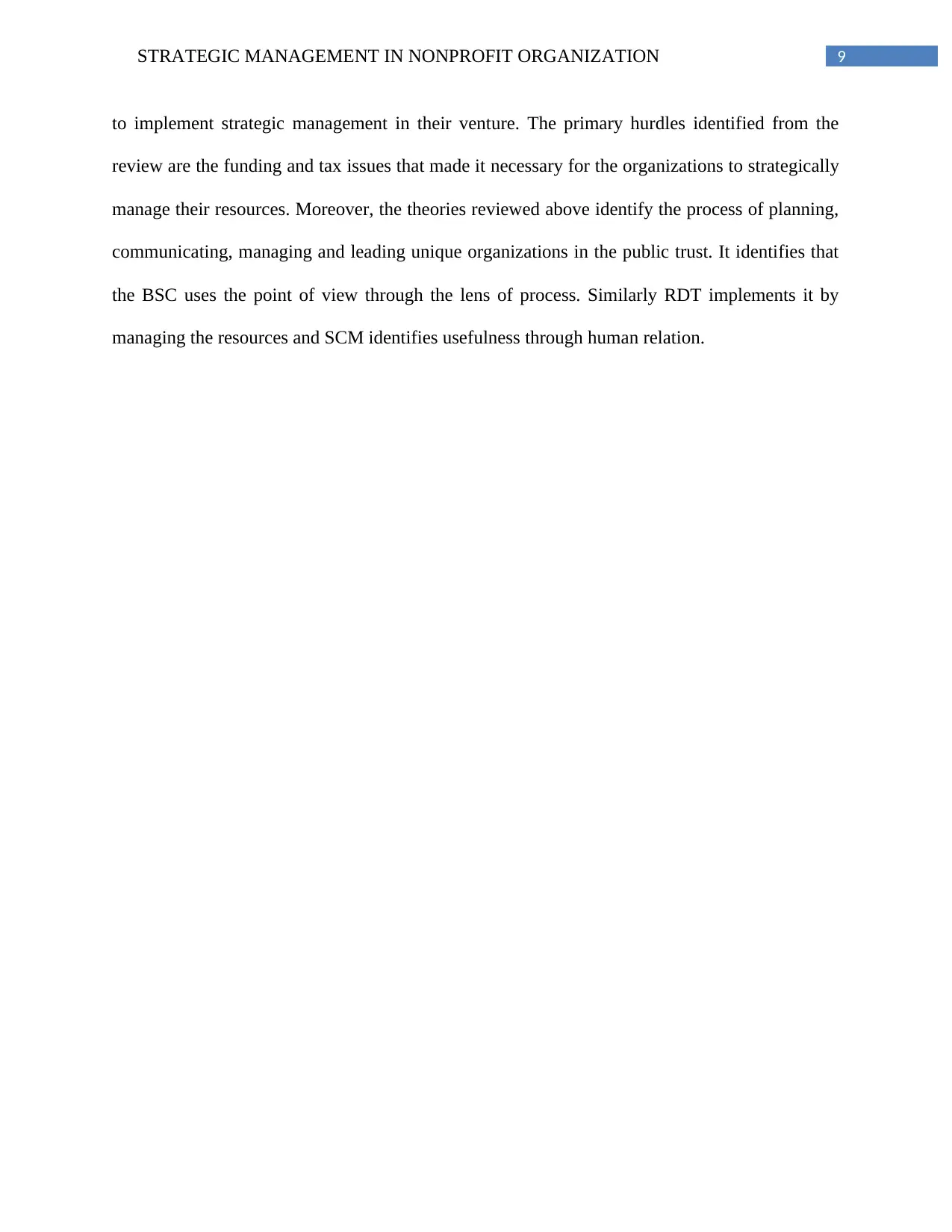
9STRATEGIC MANAGEMENT IN NONPROFIT ORGANIZATION
to implement strategic management in their venture. The primary hurdles identified from the
review are the funding and tax issues that made it necessary for the organizations to strategically
manage their resources. Moreover, the theories reviewed above identify the process of planning,
communicating, managing and leading unique organizations in the public trust. It identifies that
the BSC uses the point of view through the lens of process. Similarly RDT implements it by
managing the resources and SCM identifies usefulness through human relation.
to implement strategic management in their venture. The primary hurdles identified from the
review are the funding and tax issues that made it necessary for the organizations to strategically
manage their resources. Moreover, the theories reviewed above identify the process of planning,
communicating, managing and leading unique organizations in the public trust. It identifies that
the BSC uses the point of view through the lens of process. Similarly RDT implements it by
managing the resources and SCM identifies usefulness through human relation.
Paraphrase This Document
Need a fresh take? Get an instant paraphrase of this document with our AI Paraphraser
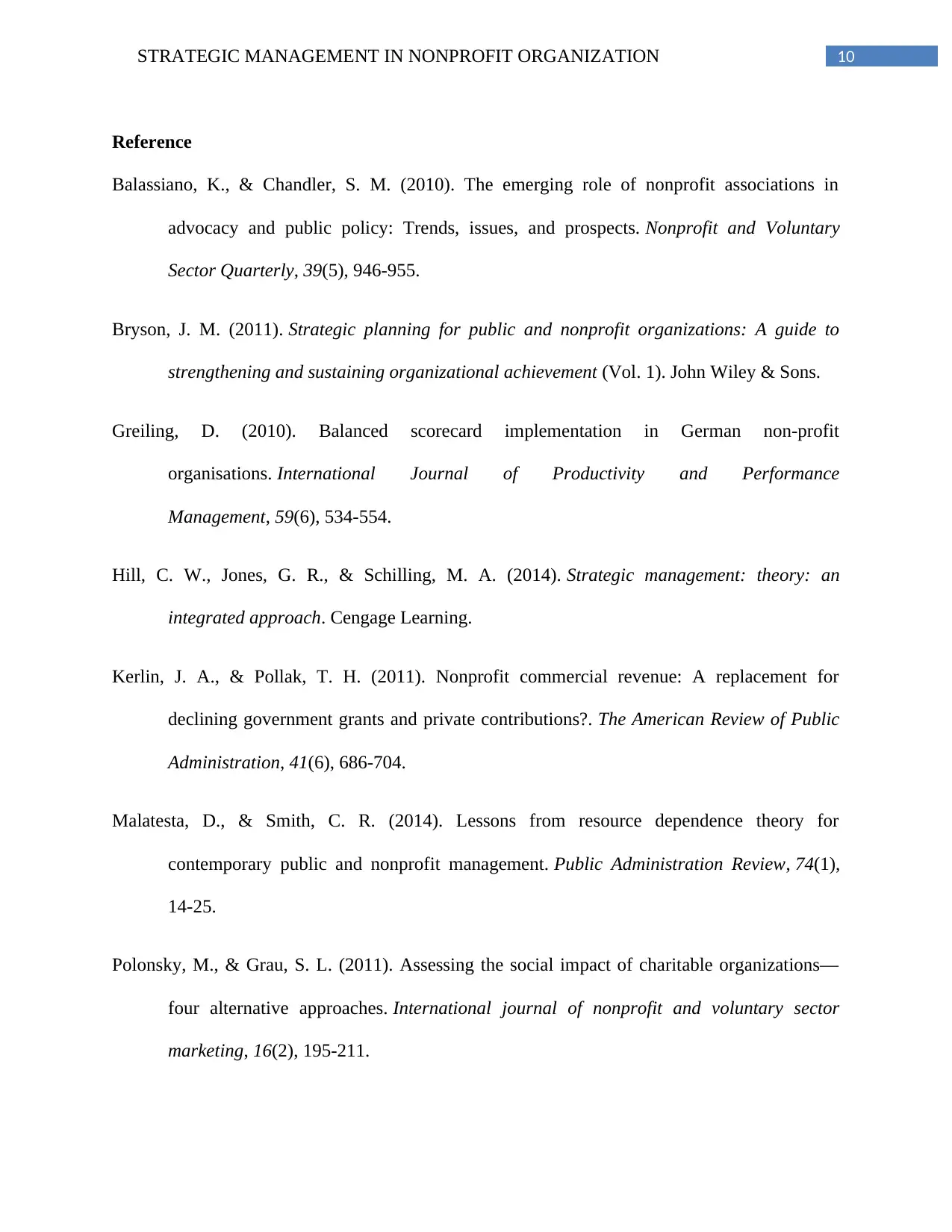
10STRATEGIC MANAGEMENT IN NONPROFIT ORGANIZATION
Reference
Balassiano, K., & Chandler, S. M. (2010). The emerging role of nonprofit associations in
advocacy and public policy: Trends, issues, and prospects. Nonprofit and Voluntary
Sector Quarterly, 39(5), 946-955.
Bryson, J. M. (2011). Strategic planning for public and nonprofit organizations: A guide to
strengthening and sustaining organizational achievement (Vol. 1). John Wiley & Sons.
Greiling, D. (2010). Balanced scorecard implementation in German non-profit
organisations. International Journal of Productivity and Performance
Management, 59(6), 534-554.
Hill, C. W., Jones, G. R., & Schilling, M. A. (2014). Strategic management: theory: an
integrated approach. Cengage Learning.
Kerlin, J. A., & Pollak, T. H. (2011). Nonprofit commercial revenue: A replacement for
declining government grants and private contributions?. The American Review of Public
Administration, 41(6), 686-704.
Malatesta, D., & Smith, C. R. (2014). Lessons from resource dependence theory for
contemporary public and nonprofit management. Public Administration Review, 74(1),
14-25.
Polonsky, M., & Grau, S. L. (2011). Assessing the social impact of charitable organizations—
four alternative approaches. International journal of nonprofit and voluntary sector
marketing, 16(2), 195-211.
Reference
Balassiano, K., & Chandler, S. M. (2010). The emerging role of nonprofit associations in
advocacy and public policy: Trends, issues, and prospects. Nonprofit and Voluntary
Sector Quarterly, 39(5), 946-955.
Bryson, J. M. (2011). Strategic planning for public and nonprofit organizations: A guide to
strengthening and sustaining organizational achievement (Vol. 1). John Wiley & Sons.
Greiling, D. (2010). Balanced scorecard implementation in German non-profit
organisations. International Journal of Productivity and Performance
Management, 59(6), 534-554.
Hill, C. W., Jones, G. R., & Schilling, M. A. (2014). Strategic management: theory: an
integrated approach. Cengage Learning.
Kerlin, J. A., & Pollak, T. H. (2011). Nonprofit commercial revenue: A replacement for
declining government grants and private contributions?. The American Review of Public
Administration, 41(6), 686-704.
Malatesta, D., & Smith, C. R. (2014). Lessons from resource dependence theory for
contemporary public and nonprofit management. Public Administration Review, 74(1),
14-25.
Polonsky, M., & Grau, S. L. (2011). Assessing the social impact of charitable organizations—
four alternative approaches. International journal of nonprofit and voluntary sector
marketing, 16(2), 195-211.
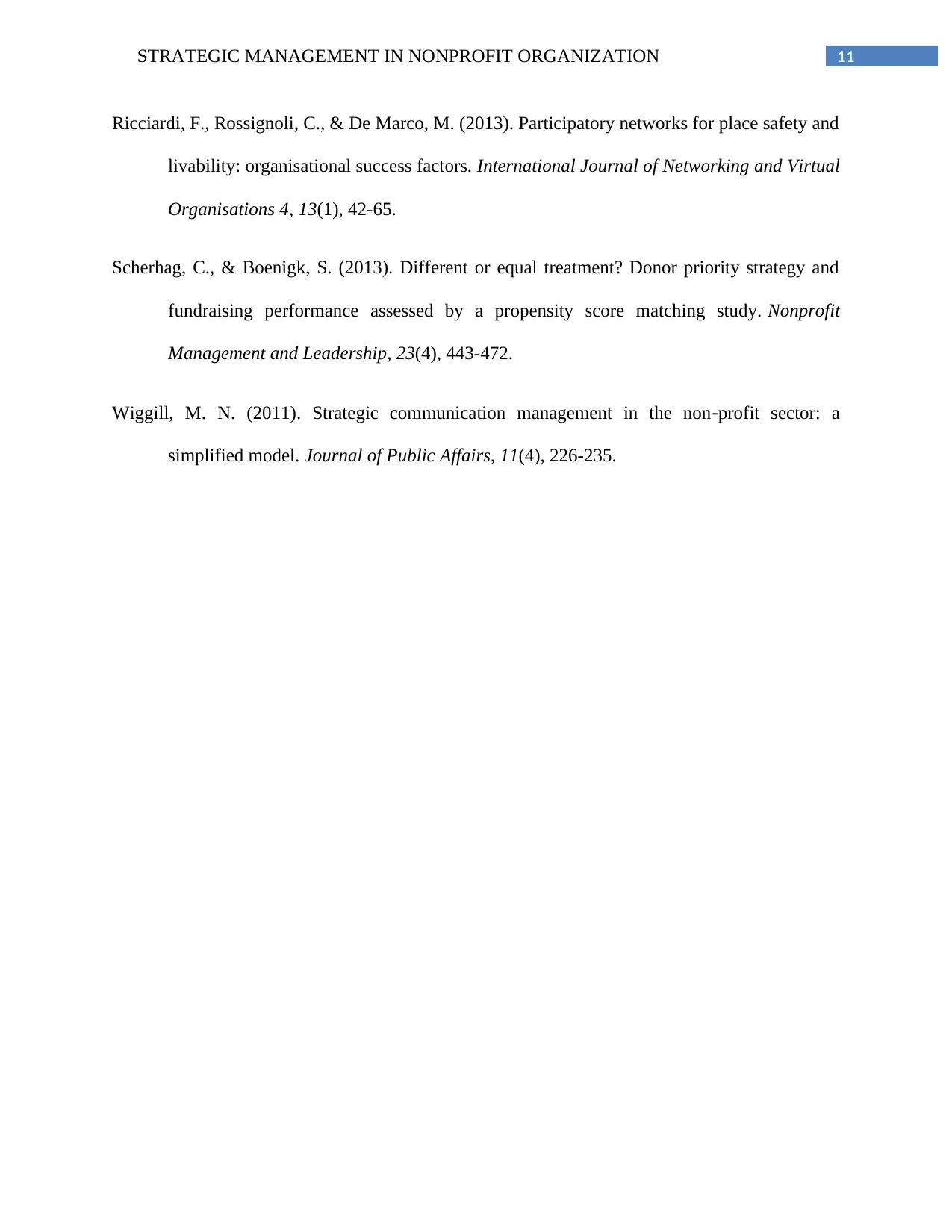
11STRATEGIC MANAGEMENT IN NONPROFIT ORGANIZATION
Ricciardi, F., Rossignoli, C., & De Marco, M. (2013). Participatory networks for place safety and
livability: organisational success factors. International Journal of Networking and Virtual
Organisations 4, 13(1), 42-65.
Scherhag, C., & Boenigk, S. (2013). Different or equal treatment? Donor priority strategy and
fundraising performance assessed by a propensity score matching study. Nonprofit
Management and Leadership, 23(4), 443-472.
Wiggill, M. N. (2011). Strategic communication management in the non‐profit sector: a
simplified model. Journal of Public Affairs, 11(4), 226-235.
Ricciardi, F., Rossignoli, C., & De Marco, M. (2013). Participatory networks for place safety and
livability: organisational success factors. International Journal of Networking and Virtual
Organisations 4, 13(1), 42-65.
Scherhag, C., & Boenigk, S. (2013). Different or equal treatment? Donor priority strategy and
fundraising performance assessed by a propensity score matching study. Nonprofit
Management and Leadership, 23(4), 443-472.
Wiggill, M. N. (2011). Strategic communication management in the non‐profit sector: a
simplified model. Journal of Public Affairs, 11(4), 226-235.
⊘ This is a preview!⊘
Do you want full access?
Subscribe today to unlock all pages.

Trusted by 1+ million students worldwide
1 out of 12
Related Documents
Your All-in-One AI-Powered Toolkit for Academic Success.
+13062052269
info@desklib.com
Available 24*7 on WhatsApp / Email
![[object Object]](/_next/static/media/star-bottom.7253800d.svg)
Unlock your academic potential
Copyright © 2020–2025 A2Z Services. All Rights Reserved. Developed and managed by ZUCOL.





